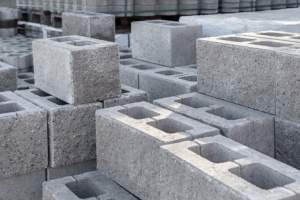Hollow bricks have become a popular choice in the construction industry due to their affordability, energy efficiency, and ability to accommodate various designs. They are also referred to as hollow blocks or concrete masonry unity (CMUs) and are known for their versatility and widespread use. These bricks are rectangular or square in shape, hence the name “hollow blocks,” and are made using sand, cement, and other aggregates.
Hollow bricks find their application in the construction industry for erecting walls, creating partitions within buildings, and constructing diverse structural elements. During the manufacturing process, the void in the hollow bricks is achieved by emptying the spaces, which can be in various shapes, including circular, square, rectangular, or other shapes as well.
See also: What are Porotherm bricks?
What is the process of manufacturing hollow bricks?
The manufacturing process of hollow bricks involves the following steps:
Selection of raw materials
To produce hollow bricks, the initial and crucial stage is to carefully choose the appropriate raw materials for the manufacturing process. The raw materials involved in preparing hollow bricks are Portland cement, sand, crushed stone, gravel, and water. To enhance the features of hollow bricks other materials like fly ash, slag, and silica could also be mixed.
Mixing the raw materials
After selecting the desired materials, the next step is to mix the materials to form a homogeneous mixture. This is done by adding the materials together in the mixer to form a homogeneous mixture.
Moulding
The moulds in which the mixture is transferred after mixing are usually made of steel or wood. These moulds come in a wide range of sizes and shapes to fit any situation. These moulds help in shaping the size and shape of the hollow bricks.
Curing
The moulded bricks are cured at a temperature suitable for the bricks to cool down. It is left to cool down for some time to develop strength and durability. The production process involved in manufacturing hollow bricks decides the type of curing required. It could be steam curing or water curing.
Demoulding
After curing is completed, it is time to get the bricks out of the moulds. This is known as demoulding. The bricks are ready to be used in the construction process of the building.
What are the applications of hollow bricks?
The following are the applications of hollow bricks:
Residential buildings
Hollow bricks are commonly used in construction of the buildings, houses, and apartments because of their properties like cost-effectiveness and insulation.
Commercial buildings
The bricks are advantageous to be used in offices, big spaces, retail areas, and buildings used as industrial areas. These spaces benefit from hollow bricks because of their insulation and energy-efficient properties.
Institutional buildings
Buildings such as schools, hospitals, and buildings of the governments use hollow bricks because of their properties to resist fire and their durable nature.
Retaining walls
Hollow bricks have strong structural strength, because of this feature it is used in retaining walls.
Pavements
The bricks are used in pavements and walkways, for paving and creating pedestrian pathways.
What are the advantages of hollow bricks?
Insulation properties
The empty spaces within hollow bricks serve as natural insulators, effectively reducing heat transfer within walls and improving overall energy efficiency in buildings. This property helps maintain a comfortable temperature inside the buildings and reduces the costs spent on heating and cooling. These bricks also offer good sound insulation for the buildings.
Lightweight
The hollow spaces of the bricks make it lightweight to use. Solid bricks are heavier as compared to hollow bricks. The lightweight of these bricks simplifies the process of handling, transporting, and installing them.
Cost-effective
Hollow bricks are a budget-friendly choice as the costs for materials used and labour costs are lower as compared to other types of bricks. This contributes to long-term savings for the homeowners, or owners of the space.
Resistant to fire
Hollow bricks are fire resistant and enhance the safety of the people using or living in the buildings. In case there is a chance of fire, these bricks protect the buildings from it.
Environment-friendly
These bricks are highly environment-friendly and reduce the carbon footprint contributing a lot towards a sustainable environment.
FAQs
Which is better: hollow bricks or solid bricks?
Hollow bricks are more advantageous because of their features such as being cost-effective, sustainable, energy-efficient, and lightweight.
Are hollow bricks customisable?
Yes, hollow bricks can be customised according to the needs of the construction.
Are hollow bricks recyclable?
Yes, hollow bricks can be reused and recyclable. They can be crushed and can be given different shapes for reusing.
Are there any disadvantages to using hollow bricks?
Hollow bricks are very advantageous to be used in buildings. However, in extremely cold climates, additional insulation techniques have to be applied.
How often do buildings survive in which hollow bricks are used?
The average life of the buildings in which hollow bricks are used is 50 to 100 years.
Can hollow bricks be used in earthquake-prone areas?
Hollow bricks provide safety to the buildings and the individuals living in earthquake-prone areas. It provides overall seismic resistance.
Do hollow bricks require specialised installation techniques?
No, hollow bricks can be installed using the general installation techniques.
| Got any questions or point of view on our article? We would love to hear from you. Write to our Editor-in-Chief Jhumur Ghosh at [email protected] |

Shimon Oberoi, an economics graduate from Rajdhani College, University of Delhi, strives to simplify the real estate world through her compelling and well-researched content. She has experience in domains like entertainment and economic concepts, among others. When not creating content, she enjoys watching movies, listening to music, and reading fictional books.











